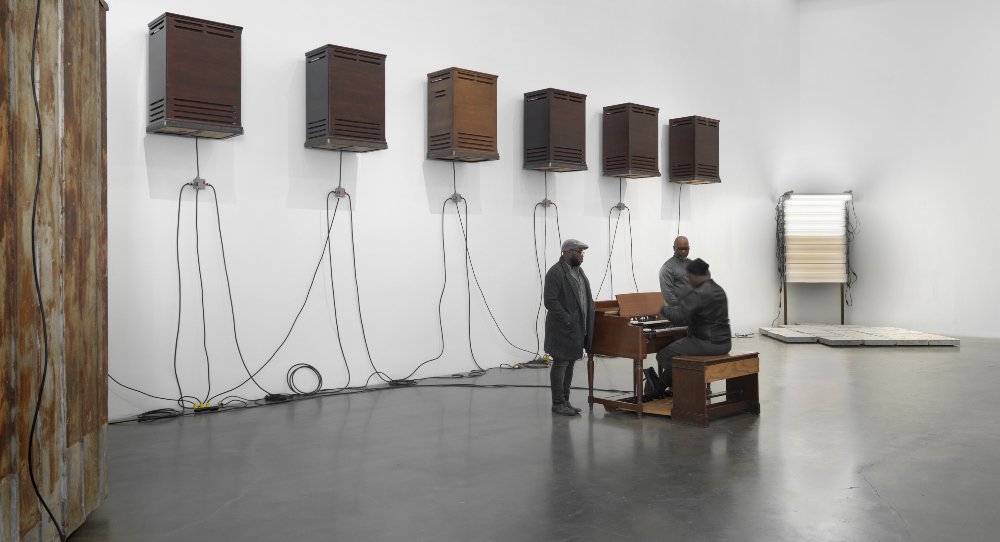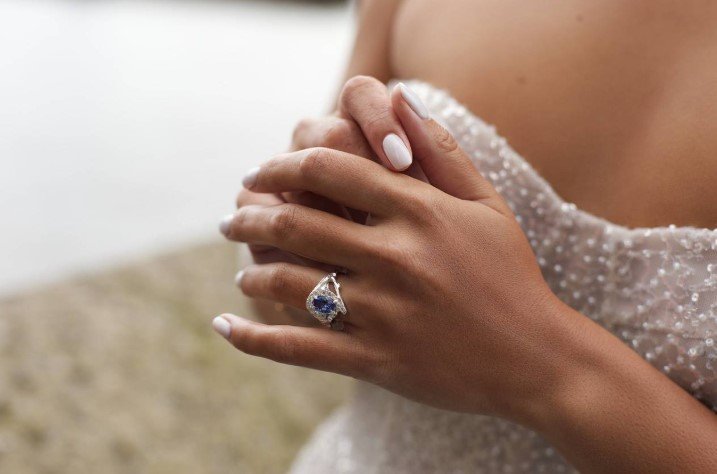During a recent visit to the New Museum, on Manhattan’s Lower East Side, music reverberated throughout the building. The sound was emanating from the fourth floor, where Shedrick Mitchell, seated behind a Hammond B-3 organ with seven wood-encased Leslie speakers nearby, was improvising a medley of gospel hymns, soul and pop songs, and his own original melodies.
Notably, this wasn’t a concert. Mitchell was activating “A Heavenly Choir,” an installation featured in a mid-career retrospective of works by the Chicago-based artist Theaster Gates. He’s globally known as a multidisciplinary artist – a ceramicist, sculptor, archivist and community planner. But Gates is also a musician, and works in his show, titled “Young Lords and Their Traces” (at the New Museum through Sunday, Feb. 5), echo that pursuit.
“Young Lords and Their Traces” offers examples of works by Theaster Gates in multiple media, surrounded at times by live music.
Courtesy New Museum
It’s rare to see a music-based art exhibition in a museum. Traditionally, these institutions showcase visual work inspired by music, or curate live performances and DJ sets for special openings or events.
But something different is happening now at three major Manhattan institutions, all at once. In addition to the Gates show at the New Museum, the Guggenheim Museum is currently showing “Nick Cave: Forothermore,” an imaginative overview of art objects deeply indebted to their creator’s connection to music. Meanwhile, at the Museum of Modern Art, “Just Above Midtown: Changing Spaces” revisits a historic New York gallery in which music was a core concern.
In a show of works by Theaster Gates at the New Museum, numerous works engage music, either as objects or in performative aspects.
Lyndon French
Each of these vital shows – two of which conclude with major events in February – reveal music’s central role to the practice of certain artists and their communities, and especially African-American communities. These multidisciplinary shows integrate musical ideas with paintings, sculptures, assemblages, installations and other media. Their results broaden common notions of contemporary art.
In Gates’s show, numerous works engage music, either as objects or in performative aspects. New Museum curator Gary Carrion-Murayari says “A Heavenly Chord” is an apt example of both.
“The church organ has a specific history that’s tied to the communal and the spiritual possibilities of music, even when it’s not activated,” Carrion-Murayari said. “Those speakers that are on the wall, they’re beautiful aesthetic objects. But they also speak to a history of music, and the popular potential of an object to make a communal musical experience happen in a space that’s connected to Black history. All of those things are there in those objects, whether they’re activated or not.”
Theaster Gates (third from left) activates his visual art through performances with a musical group, The Black Monks.
Veikko Somerpuro
And, as Mitchell’s regular presence at the New Museum indicates, one way Gates musically activates his art is by staging performances around it. Gates, who grew up as a choir singer and music director in a church on Chicago’s South Side, founded a group called the Black Monks, which includes some of the city’s finest musicians. The Monks play a spontaneous, improvised mix of jazz, gospel, blues and Buddhist chants – no two performances are alike.
“Whether objects are musically focused or not, the potential for them to be activated by the Monks can always grow,” Carrion-Murayari said. “There’s always possibilities for these really amazing experiences.” Chance is central to the way Gates regards music. “Improvisation is so important to him,” Carrion-Murayari explained, “because there may be structures that you start from, but really surprising unexpected things can happen.”
Self-invention through improvisation
Music and improvisation are also foundational to “Nick Cave: Forothermore,” the artist’s retrospective at the Guggenheim, featuring sculptures, assemblages, textile work and videos from throughout the artist’s 30-plus year career. Cave, 63, is popularly known for a body of work he calls “Sound Suits” – colorful sculptural costumes he’s created in response to the traumatic violent deaths of young Black men and women in America. (He began making them periodically, after seeing the video of LAPD’s assault of Rodney King in 1991.) The suits, central to “Forothermore,” have been used in dance and movement performances that can feel like ceremonies.
Cave grew up in small-town Missouri, and gravitated toward clothes-making and dance music early on. He cites 1970s acts that mixed funk with glamor, including LaBelle and Parliament-Funkadelic, as his primary inspirations. Cave went on to study dance with Alvin Ailey, and is now a professor in the fashion program at the School of the Art Institute of Chicago.
Colorful, ritualistic “Sound Suits” emphasize self-invention and ritual in “Nick Cave: Forothermore” at the Guggenheim Museum.
Ariel Ione Williams for the Guggenheim Museum
For him, improvising with style and movement in nightclubs was initially a mode of self-invention, but became a lifelong stimulant – “this amazing sort of space of independence and liberation.” He cites nightclub dance floors as the primary venues where he found himself and his personal creative point of view.
“It was transformative,” Cave said. “It allowed me to let go of everything, and not be confined by the surroundings, in how people present themselves. Everybody was there for this sense of liberation, being able to just be expressive.”
In “Nikki,” a recently excavated 1988 video featured in “Forothermore,” Cave delivers a monologue while transforming from a male to a female character, on their way to a night of clubbing, as house music pulses behind. That freedom to improvise his identity, and to find the physical release of the dance floor, is essential to the work he makes. “I’m thinking about those ideas,” Cave said, “and how do I translate that emotion, that concept, into an object.”
Nick Cave says that dance music played a “transformative” role in his life and his artistic practice.
Sandro Miller
For Naomi Beckwith, the Guggenheim’s deputy director and chief curator, another aspect to be gained from Cave’s life within the club culture is its embrace of making art as part of a community practice.
“His experiences on the dance floor get us to where he’s also talking about inspiration coming in a group context,” Beckwith said. “That to dance itself – and especially in the club, on the streets, in these kind of social arenas – is an act of perpetual creativity, where one is feeding off the energies of others. That kind of collective energy became so important for the ways in which not only he lives his life, but the way he works now.”
‘We were always playing music’
Similar collective energy permeates “Just Above Midtown: Changing Spaces,” a sprawling historic group exhibit now on view at MoMA. Just Above Midtown – or JAM – was a Manhattan gallery founded by Linda Goode Bryant, and active from 1974 through 1986. Never financially stable, JAM moved three times, from 57th Street to Nolita, and then to SoHo. But it championed the work of Black artists who went on to great critical acclaim, like David Hammons, Howardena Pindell and Lorraine O’Grady, whose works are all included in “Changing Spaces.”
Bryant says that music was central to JAM – its programming, its spirit, even its survival – from the start. “One of the things that really distinguished JAM from the other galleries on 57th Street was that we were always playing music,” she said, laughing. “Black musicians were coming in all the time … Stevie Wonder. We had a relationship with Roberta Flack. There was a huge recording studio in that building at 50 West 57th St., so Miles Davis would come down. The folks who came to openings and came to JAM were musicians.” (A portrait of Flack by the Jamaica-born painter Mallica “Kapo” Reynolds occupies a prominent space in the exhibit.)
Linda Goode Bryant says that music played several crucial roles in her gallery Just Above Midtown, now the subject of a MoMA show.
Camille Billops
JAM also provided a space where musicians could work out new ideas. The late Lawrence D. “Butch” Morris, a cornetist, composer and arranger, organized the sounds of large improvising ensembles using a system he called “conduction,” while also working with other gallery artists. (A video of “Air Popo,” Morris’ 1981 multimedia collaboration with visual artist Senga Nengudi and dancer/choreographer Cheryl Banks-Smith is installed in “Changing Spaces.”) When JAM moved to larger downtown spaces in the 1980s, jazz musicians like Steve Coleman, Geri Allen and Cassandra Wilson developed early work there.
The gallery also nurtured the Black Rock Coalition, a collective co-founded by the late music critic Greg Tate. BRC would play a key role in desegregating New York’s punk scene, and helped jump-start bands like Living Colour. “They came there, they met, they debated, they created together in that space” Bryant said. Flyers and posters for musical events staged at the gallery’s final space, at 503 Broadway, or co-produced by JAM, adorn one of the exhibit’s final walls.
Next weekend, MoMA will affirm those historic ties when it hosts performances of Butch Morris-style conductions, featuring Vernon Reid of Living Colour, Tate’s former bandmates in Burnt Sugar, and other BRC associates.
“Just Above Midtown: Changing Spaces,” on view now at the Museum of Modern Art, shows the disparate artistic pursuits that came together in a historic gallery.
Emile Askey for Museum of Modern Art
True to its acronym, JAM prided itself on the creative synergy that flowed within its spaces. Making music became a kind of model for what the gallery was about, regardless of the disciplines. “It was a cross pollination of different forms of creative expression that fall within the ‘art’ category of creativity,” Bryant said. “They were going on side by side, simultaneously.”
New Museum artistic director Massimiliano Gioni, who helped curate the Theaster Gates exhibit, says while the blending of mediums JAM encouraged is a newer venture for museums, historically it had been natural among artists.
“There is a dream of interdisciplinarity embedded in the history of 20th and 21st century art,” Gioni said. “In a sense, we are trying to break down hierarchies that were more created on the institutional front, rather than on the artistic front. The museums are catching up with something that artists had no issues about.”
What all three exhibits share in common, Beckwith points out, is a focus on artists who center music as an essential part of Black creative expression.
“The more that we can talk about these modes of working from these amazing Black communities – incorporating experimentation, incorporating collective practice, really thinking about the body – the more that we are absolutely enriching the story of art history.”
“Theaster Gates: Young Lords and Their Traces” runs through Feb. 5, at The New Museum. “Just Above Midtown: Changing Spaces” is at the Museum of Modern Art through Feb. 18. “Nick Cave: Forothermore” is at the Guggenheim Museum of Art through April 10.





More Stories
Turner’s watercolours are at the National Gallery of Ireland for January. It’s worth seeing them in person – The Irish Times
National Gallery spent more than $2-million on severance over period of 2 ½ years
National Gallery of Canada’s show must go on – minus senior curators (for now)